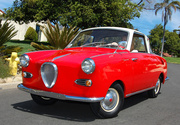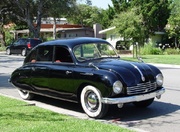
The blogs are buzzing this morning with news that a 1939 Plexiglass body Pontiac made by General Motors for the New York World’s Fair, sold at auction for $308,000. In fact, a lot of manufacturers of traditionally opaque goods made see-through versions of their products. Here are a few of our favorite clear things.

The Ghost Car. This 1939 Pontiac Deluxe Six was one of the highlights of the 1939-40 New York World’s Fair (see above), which was focused entirely on the future. GM worked with Rohm & Haas, which had only introduced plexiglass sheets a few years before. According to RM Auctions which just sold the car, the vehicle’s structural metal was given a copper wash and its hardware was chrome plated, since it was now more visible to the eye. The cost of the project at the time was reportedly $25,000, which is just over $391,000 in 2011 dollars, which I guess means the price paid at auction was a good deal.
The Western Electric 302. Designed by Henry Dreyfuss, the 302 was the workhorse of the Bell System for two decades. This example from TelephoneCreations.com was cast in clear resin. Like the Ghost Car, it was made for the New York World’s Fair.
Jelly Bellies. Some of the most sought-after pieces of costume jewelry are the Jelly Belly brooches and pins, pioneered by Trifari in the 1930s and emulated by Coro and other manufacturers after that.
Lucite Handbags. According to author and vintage expert Janice Berkson, whose book, “Carry me!,” is the definitive work on 1950s Lucite handbags, designers such as Will Hardy and Llewellyn Bley embraced Lucite to make clutches and purses that were like mini pieces of sculpture.
Visible Man/Woman. As Lisa Hix explained last month in her article about educational toys of yesteryear, the first Visible Man appeared in 1958, when a company named Renwal introduced a 16-inch clear plastic model of a human man with visible bones and internal organs.
Electric Guitars. In 1957, Fender began a project to create a see-through Stratocaster made out of Lucite (above left). Completed in 1961, the prototype guitar was not put into production because, among other reasons, it weighed 18 pounds. From 1969 to 1971, guitar maker Dan Armstrong made a number of clear, acrylic-body guitars with Ampeg (above right). Those guitars were lighter because they were made of Plexiglass and had a wooden neck. The Armstrong guitars were reissued from 1998 until 2001.
What are your favorite see-through things? Let us know in the Comment box below.








 The VW Bug's Rare and Quirky Czech Mate
The VW Bug's Rare and Quirky Czech Mate
 This 1959 Goggomobil Is Insanely Cute and Gets 55 MPG. Why Can’t Detroit Do That?
This 1959 Goggomobil Is Insanely Cute and Gets 55 MPG. Why Can’t Detroit Do That? The VW Bug's Rare and Quirky Czech Mate
The VW Bug's Rare and Quirky Czech Mate Riding the Classics, from Chevys to Schwinns
Riding the Classics, from Chevys to Schwinns Model 302 TelephonesIntroduced in 1936, the model 302 was the first Western Electric telephone …
Model 302 TelephonesIntroduced in 1936, the model 302 was the first Western Electric telephone … Stratocaster GuitarsThe Stratocaster was not the first Fender solid-body electric guitar—that h…
Stratocaster GuitarsThe Stratocaster was not the first Fender solid-body electric guitar—that h… Jelly Belly JewelryOne of the most immediately recognizable examples of vintage costume jewelr…
Jelly Belly JewelryOne of the most immediately recognizable examples of vintage costume jewelr… Mari Tepper: Laying it on the Line
Mari Tepper: Laying it on the Line Nice Ice: Valerie Hammond on the Genteel Charm of Vintage Canadian Costume Jewelry
Nice Ice: Valerie Hammond on the Genteel Charm of Vintage Canadian Costume Jewelry How Jim Heimann Got Crazy for California Architecture
How Jim Heimann Got Crazy for California Architecture Modernist Man: Jock Peters May Be the Most Influential Architect You've Never Heard Of
Modernist Man: Jock Peters May Be the Most Influential Architect You've Never Heard Of Meet Cute: Were Kokeshi Dolls the Models for Hello Kitty, Pokemon, and Be@rbrick?
Meet Cute: Were Kokeshi Dolls the Models for Hello Kitty, Pokemon, and Be@rbrick? When the King of Comedy Posters Set His Surreal Sights on the World of Rock 'n' Roll
When the King of Comedy Posters Set His Surreal Sights on the World of Rock 'n' Roll How One Artist Makes New Art From Old Coloring Books and Found Photos
How One Artist Makes New Art From Old Coloring Books and Found Photos Say Cheese! How Bad Photography Has Changed Our Definition of Good Pictures
Say Cheese! How Bad Photography Has Changed Our Definition of Good Pictures Middle Earthenware: One Family's Quest to Reclaim Its Place in British Pottery History
Middle Earthenware: One Family's Quest to Reclaim Its Place in British Pottery History Fancy Fowl: How an Evil Sea Captain and a Beloved Queen Made the World Crave KFC
Fancy Fowl: How an Evil Sea Captain and a Beloved Queen Made the World Crave KFC
I have a copy from a 1905 Telephone Journal that showa a see-through plate and cut glass wall telephone. It was manufactured by the Swedish-American Telephone Co and was displayed at the National-Interstate telephone show.
http://www.youtube.com/watch?v=MlGXdNQfZx4
The Gleeman Pentaphonic Clear Synthesizer is a longtime fave
Vox made a lucite AC30 amplifier in the mid ’60’s for trade shows.
The Clear Macintosh SE
http://cache.gawker.com/assets/images/gizmodo/2009/05/SE1.jpg.jpg
If one was to blow up the first photo of the “Ghost Car”, and look at the ghost license plates, one would note that the plate says thusly, “1940 or 41 Pontiac”. I really can’t see it clearly enough to tell. None the less, somebody has some ‘splainin’ to do.